The Edomites
Edom is Esau
Mt. Seir, Mt. Paran
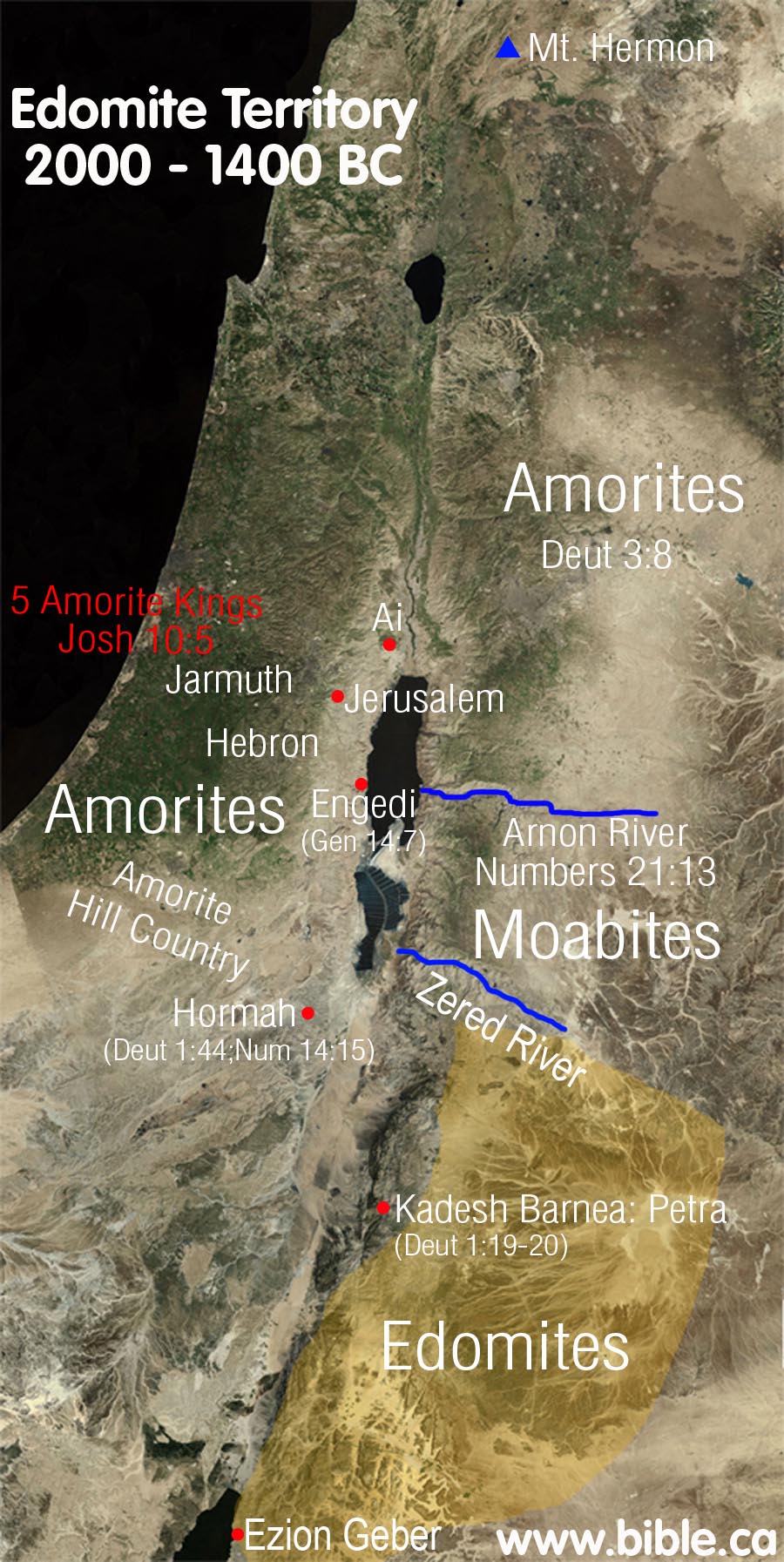 |
Seir occupied by Horites in 2000 BC Esau first occupied "Edom" in 1920 BC: Genesis 36 Edom continuously occupied from 1920-1000 BC |
- Seir was the first inhabitant of the "land of Seir" (Gen 36:30) before the birth of Esau. The Horites were descended from Seir, but the origin of Seir is not recorded in the Bible. There is an extensive list of the descendants of "Seir the Horite" their rulers in Genesis 36:20-30.The etymology of Horite appears to be connected with living in caves. So Seir was a man who lived in caves: "Seir the Horite" or Seir the cave dweller.
- The Edomites had their origin in 2000 BC at the birth of Esau. The Edomites were descended from Esau who is the brother of Jacob and son of Isaac. "Now these are the records of the generations of Esau (that is, Edom)." Genesis 36:1; "So Esau lived in the hill country of Seir; Esau is Edom." Genesis 36:8; "These are the chiefs of Edom (that is, Esau, the father of the Edomites), according to their habitations in the land of their possession." Genesis 36:43
- In 1920 BC, Esau first moved to Seir (which became the land of Edom) in before the return of Jacob from Laban.
- When Esau moved to Seir, he killed off the Horites and took over the land. "The Horites formerly lived in Seir, but the sons of Esau dispossessed them and destroyed them from before them and settled in their place, just as Israel did to the land of their possession which the Lord gave to them.)" Deut 2:12.
- Esau had continuous occupation of "Seir" from the time he first moved there in 1920 BC, down to the Exodus in 1446 BC: "just as He did for the sons of Esau, who live in Seir, when He destroyed the Horites from before them; they dispossessed them and settled in their place even to this day." Deuteronomy 2:22
- Isaac was born in 2060 BC: Genesis 25:26. Isaac died in 1880 BC: Gen
35:28. Esau and Jacob were born in 2000 BC. Isaac blessed Esau and
Jacob in 1923 BC. After Jacob stole the blessing of Esau, he moved away
for 21 years to live with Laban. Upon returning Jacob meets Esau at the
crossing point of the Jabbok river. This is transjordan. Interesting to
note that at this time, Edom already was known to live in Seir: "Please
let my lord pass on before his servant, and I will proceed at my
leisure, according to the pace of the cattle that are before me and
according to the pace of the children, until I come to my lord at Seir."
Esau said, "Please let me leave with you some of the people who are
with me." But he said, "What need is there? Let me find favor in the
sight of my lord." So Esau returned that day on his way to Seir."
Genesis 33:14-16 Therefore Esau was already living in "Edom" in 1902 BC
when the two brother's reunited after Jacob returned from Laban.
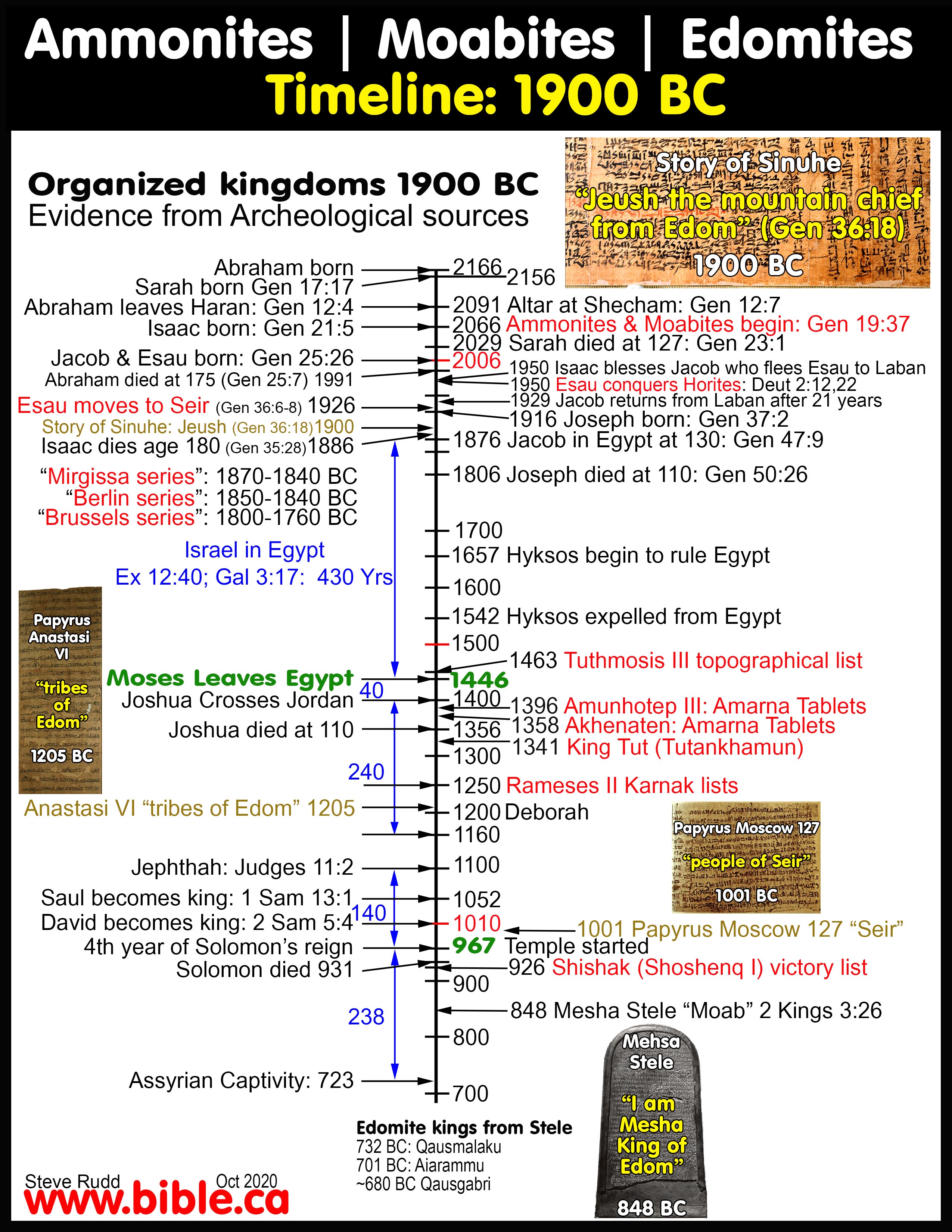
- The Edomites are a transjordan tribe whose territory was between Petra and the Red sea. Petra represented an east/west boundary between Edom and Moab. This is illustrated in the fact that Israel asked both Edom and Moab for permission to cross their lands from Kadesh.
- At the time of the Exodus, Edom did not live west of the Arabah valley. Edom remained transjordan from 2000 BC the until after the Babylonian captivity of 586 BC. When Judea was deported, Edom moved in to fill the void.
- Kadesh Barnea and Mt. Hor are on the border of Edom. It is a myth that Edom lived in the Negev at the time when Israel lived at Kadesh Barnea.
- Since Edom was transjordan at the time of the Exodus, Kadesh cannot be located at Ein Qudeirat, south of Beersheba and in the modern Sinai desert. Kadesh must also be located transjordan, probably at or near Petra.
- Mt. Seir was their stronghold which is located just a few miles north east of Elat.
- Archeology proves Edom did not come into Judah until 700 BC. Therefore since Kadesh was on the border of Edom, it must be south east of the dead sea at or near Petra. This is also outside the promised land. Ein Qudeirat cannot be Kadesh because it is no where near Edom and it is 28 km inside the formal stated boundary of the promised land.
|
Exodus period Nations in Canaan
|
||
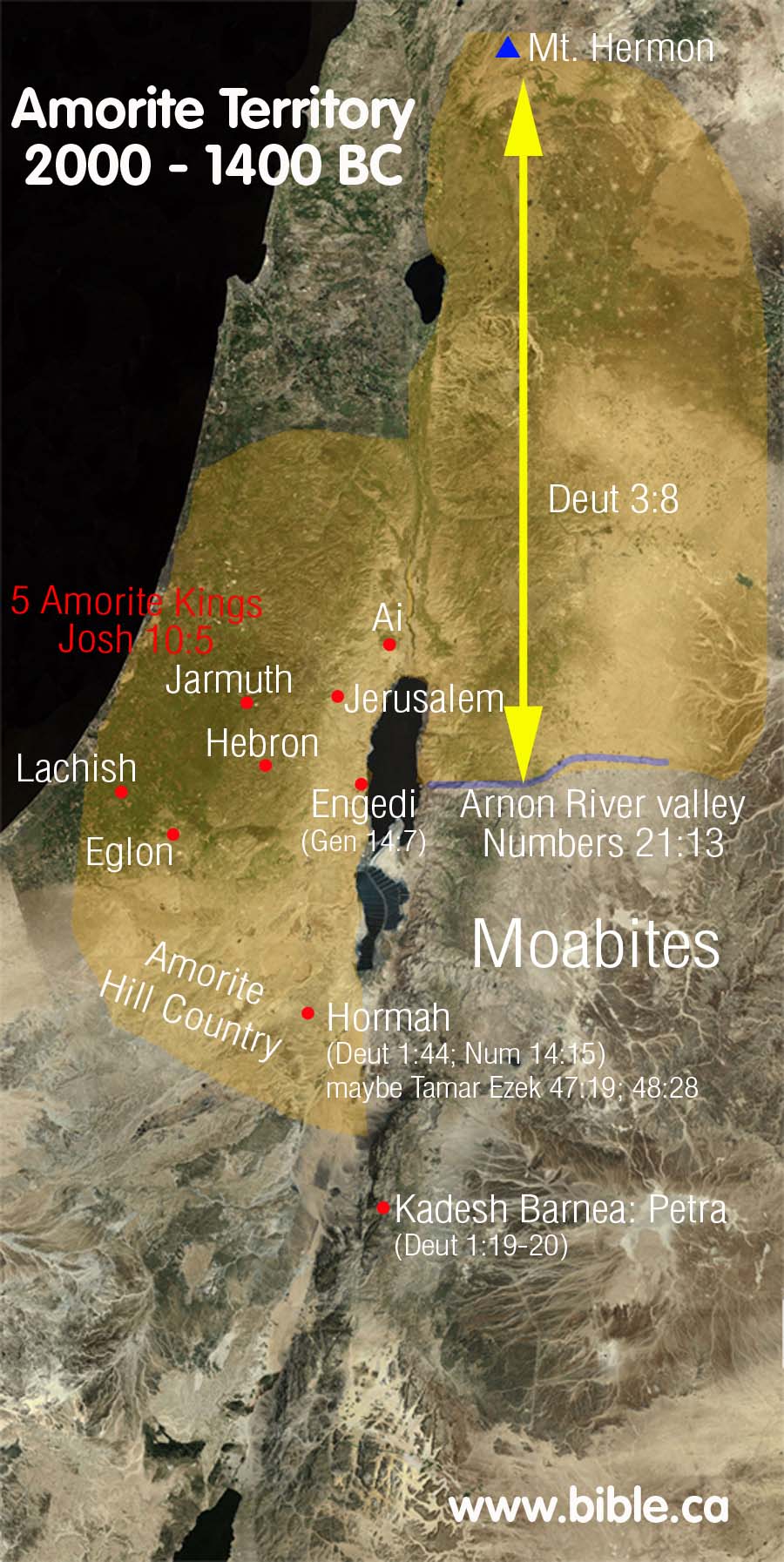 |
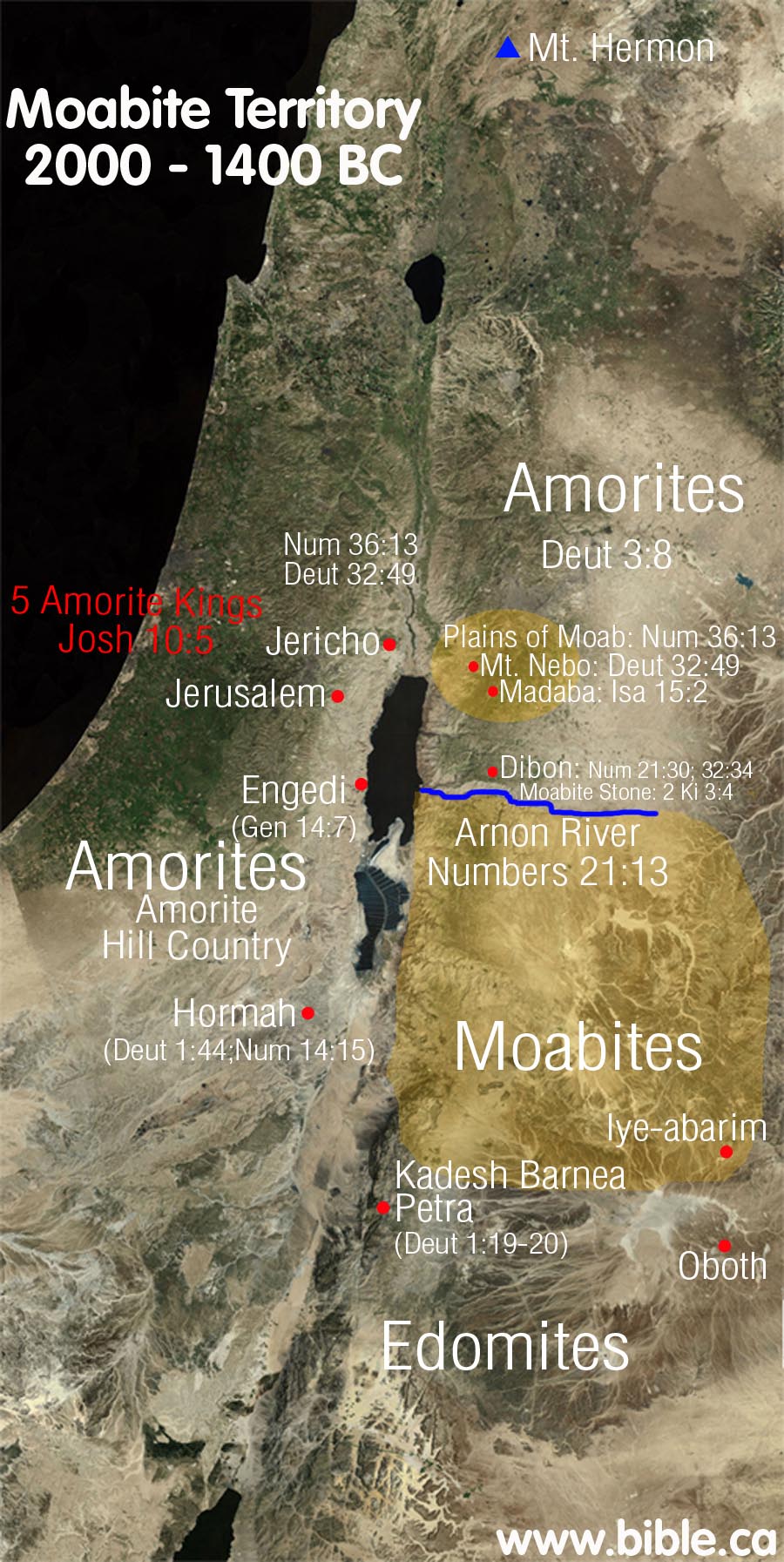 |
 |
- The most critical issue is to firmly establish that Edom was transjordan at the time of the Exodus.
- Edom remained transjordan from 1920 BC the until after the Babylonian captivity of 586 BC. When Judah vacated the Negev under deportation orders, the Edomites moved in to the Negev for the first time in history.
- The earliest evidence from Egyptian archaeological finds, proves Edom was always transjordan.
- Notice that David 1000 BC and Amaziah 797 BC, fought Edom in the Arabah valley, not in the Negev. This proves that Edom's territory was not in the Negev.
- Notice that Edom was still transjordan during the time of Jehoshaphat. The southern longer route around the Dead Sea, then across in to modern Jordan then north to Moab, intersected the wilderness of Edom. This proves Edom was transjordan: "Then he went and sent word to Jehoshaphat the king of Judah, saying, "The king of Moab has rebelled against me. Will you go with me to fight against Moab?" And he said, "I will go up; I am as you are, my people as your people, my horses as your horses." He said, "Which way shall we go up?" And he answered, "The way of the wilderness of Edom. So the king of Israel went with the king of Judah and the king of Edom; and they made a circuit of seven days' journey, and there was no water for the army or for the cattle that followed them." 2 Kings 3:7-9
- The northern border of Edom with Moab was parallel with Kadesh (Petra) Judges 11:15-18 teaches us that the border between Moab and Edom, was and east west line that ran through Kadesh at Petra. Since Kadesh was right on the borders between Moab and Edom, they asked both Moab to pass from Petra north-east and Edom to pass south-east. Both refused.
- Notice when Edom's prince fled he was allied with Midian, another transjordan nation: "Then the Lord raised up an adversary to Solomon, Hadad the Edomite; he was of the royal line in Edom. " 1 Kings 11:14 "They arose from Midian and came to Paran; and they took men with them from Paran and came to Egypt, to Pharaoh king of Egypt, who gave him a house and assigned him food and gave him land. " 1 Kings 11:18.
- Notice that David 1000 BC and Amaziah 797 BC, fought Edom in the Arabah valley of Salt, not in the Negev. This proves that Edom's territory was not in the Negev. These are large slaughters and prove the center of power for Edom was transjordan and not in the Negev. If Edom was anywhere near Ein Qudeirat, as some wrongly believe, you would have records of some of these battles taking place in the Negev. The silence is important. The fact that two battles took place in the Arabah valley of Salt is as significant as it is instructive: 1000 BC: "So David made a name for himself when he returned from killing 18,000 Edomites in the Valley of Salt." 2 Samuel 8:13 800 BC: "Now Amaziah strengthened himself and led his people forth, and went to the Valley of Salt and struck down 10,000 of the sons of Seir. The sons of Judah also captured 10,000 alive and brought them to the top of the cliff and threw them down from the top of the cliff, so that they were all dashed to pieces." 2 Chronicles 25:11-12. Amazingly, after defeating Edom, Amaziah started worshipping the Edomite idols: 2 Chronicles 25:14-16.
- Nelson Glueck recognized that Edom was transjordan: "Why it was that an inspired handful of religious geniuses in Israel and Judah developed the idea of one great God, and that the people of the Book has maintained itself to this very day, while Edom and the Edomites, and the other contemporary kingdoms and peoples of transjordan have long since disappeared into the limbo of the past, is explained by the rational as an accident of history, and by the religious as the result of the handiwork of God." (The Civilization of the Edomites, Nelson Glueck, 1947 AD)
- This map put from Biblical Archeological Review, (Dec 1996) proves
that all archeologists know Edom did not move into the Negev any earlier
than 800 BC. Note that the blue text on the map was added by us and it
not on the original map. The blue words, however, summarize the essence
of the BAR article.
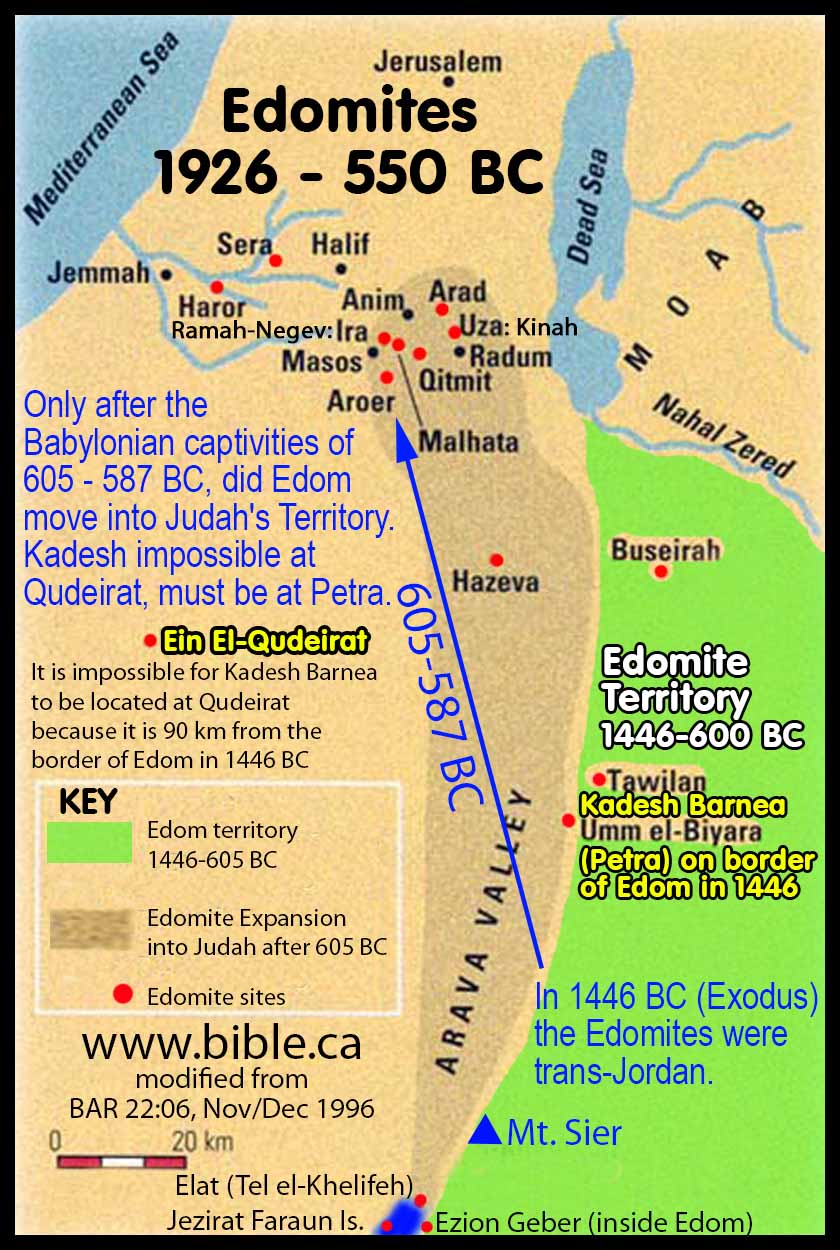
- The Edomites were living at Petra at the time Judah went into Babylonian captivity. When Judah was deported, only then, for the first time, did the Edomites move into the Negev: "The Petrans' revenge on Judah: In the late 600 BCE, the smaller kingdoms of the Middle East were gripped by fear of the aggressive might of Babylonia (modern Iraq), the super-power at the head of the Persian Gulf. In the face of this threat the Triad worshippers of Petra actually became allies of the Judaeans for a brief time, but this alliance was only superficial and when Jerusalem (then held by the Judaeans) fell to Babylon in 586 BCE after a two-year siege, the Petrans could not resist their glee as the city was burned and everything reduced to rubble. At last they were seeing their revenge for their ancient grievances. The Judaeans who managed to flee from the city were hunted down and shown no mercy. Their lamentations also contained a warning to the triumphant Petrans, who assisted the Babylonians in the decimation of the city and its inhabitants: "Our pursuers were swifter than the vultures in the sky, they chased us on the mountains, they lay in wait for us in the wilderness . . . [you may] rejoice and be glad, O daughter of Edom, dweller in the land of Uz; but to you also the cup shall pass!" (Lam. 4:18-22). The Petrans jubilantly chanted "Down with it! Even to the foundation" as the Babylonians systematically destroyed Jerusalem. Psalm 137 records the cry of one aggrieved Judaean against the Babylonians: "Blessed be he who shall deal with them as they dealt with us! Blessed be he who shall take their little ones and dash their heads against the rocks!" If the Petrans had truly helped or encouraged the Babylonians to seize fleeing infants and kill them in this horrific manner, one can understand the curses against them that were to follow. But any retribution for the Judaeans was not yet - they were carried off captive, and the Petran Edomites immediately moved into the derelict territory and set up a new kingdom, known as Idumaea (now the Negev in Israel)." (Rolalyn Maqsood, Petra: A traveler's Guide, 1994 AD)
- In 1884 AD, Henry Trumbull popularized the idea that Kadesh was not at Petra, as had been believed for 2000 years before him, but at Qedeis. He comments on how there is a need to redefine the land of Edom in a new way. He suggests that Edom was not limited to the transjordan, but right beside Kades in the land of Judah: " "This identification, with its linkings, necessitates the re-shaping of much of the geography of the southern border of Palestine and the neighboring regions, as indicated in the maps, cyclopedias, commentaries, and guide-books, now in common use. For example, as the westernmost limit of Edom is not indicated in the Bible except by its relation to Kadesh-barnea, that limit now passes from an unknown to a known quantity, by the fixing of a site which is described as just beyond it. So, also, the traditional Mount Hor must be recognized as an impossible Mount Hor; and the central and northern Arabah must no longer be counted a main camping-ground of the Israelites in their wanderings." (Kadesh-Barnea, Henry Clay Trumbull, 1884 AD, p 320)
- Here is a "map of errors" that is based solely on mistake of locating Kadesh at Ein Qudeirat.
Since the Bible says that Kadesh and Mt. Hor were on the border of
Edom, they just move Edom west into the Negev without any Biblical,
historic or archeological basis. It is one of the worst cases of
circular reasoning we have seen, and perhaps one of the more damaging.
By rewriting maps to bring Edom into the Negev, where they never lived
before 800 BC, it gives false support to Kadesh Barnea being located at Ein Qudeirat.
They know they must do this, because if Edom was not transjordan at the
time of the Exodus, then so was Kadesh. It also automatically
disqualifies Kadesh and Mt. Hor to be located at Ein Qudeirat.
These amateur mappers are not content to just move Edom, they also move
the Negev so far north, that none of the Negev is in the Negev! The
Negev is actually located from the Ramon Canyon south to Elat and edges
on the Arabah valley. Then they just start randomly choosing no less
than three locations for Mt. Hor, none of which are correct. They also
randomly pick a location for Mt. Seir at Jebel esh-Shera (or Shairah)
located about 16 km west of Elat. None of these locations have the
slightest historic or archeological basis. However, they do correctly
identify Mt. Hor beside Petra, which is the historic location of Aaron's
tomb since the time of Josephus.
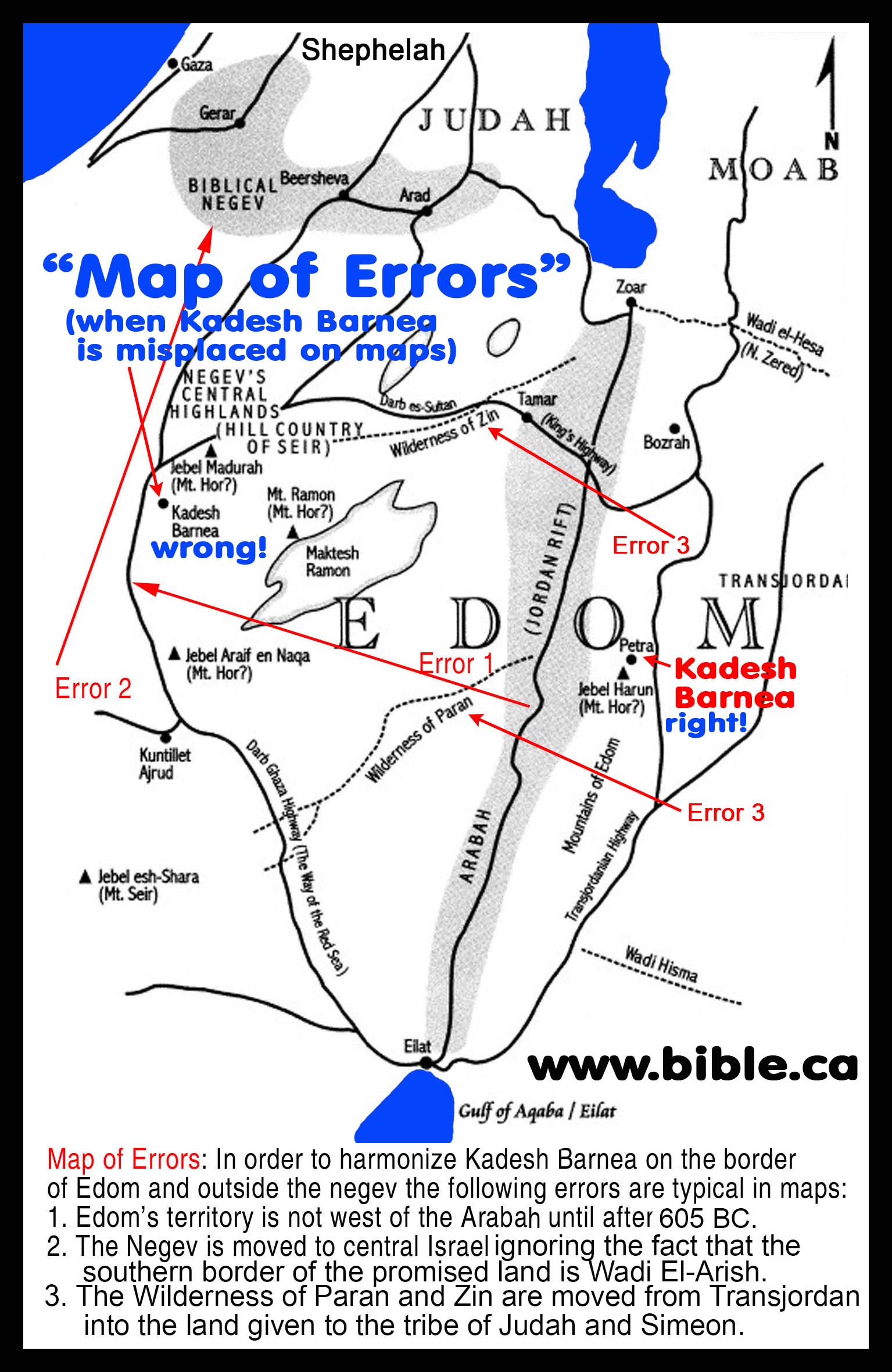
- "From Kadesh Moses then sent messengers to the king of Edom "Thus your brother Israel has said, 'You know all the hardship that has befallen us; that our fathers went down to Egypt, and we stayed in Egypt a long time, and the Egyptians treated us and our fathers badly. 'But when we cried out to the Lord, He heard our voice and sent an angel and brought us out from Egypt; now behold, we are at Kadesh, a town on the edge of your territory. " Numbers 20:14-16
- "For when they came up from Egypt, and Israel went through the wilderness to the Red Sea and came to Kadesh, then Israel sent messengers to the king of Edom, saying, "Please let us pass through your land," but the king of Edom would not listen. And they also sent to the king of Moab, but he would not consent. So Israel remained at Kadesh. 'Then they went through the wilderness and around the land of Edom and the land of Moab, and came to the east side of the land of Moab, and they camped beyond the Arnon; but they did not enter the territory of Moab, for the Arnon was the border of Moab. Judges 11:16-18
- "They journeyed from Ezion-geber and camped in the wilderness of Zin, that is, Kadesh. They journeyed from Kadesh and camped at Mount Hor, at the edge of the land of Edom. " Numbers 33:36-37
- "It is eleven days' journey from Horeb by the way of Mount Seir to Kadesh-barnea. " Deuteronomy 1:2
- ""Then we set out from Horeb, and went through all that great and terrible wilderness which you saw on the way to the hill country of the Amorites , just as the Lord our God had commanded us; and we came to Kadesh-barnea. " Deuteronomy 1:19
- "Then the sons of Israel, the whole congregation, came to the wilderness of Zin in the first month; and the people stayed at Kadesh. Now Miriam died there and was buried there. " Numbers 20:1
- "for in the wilderness of Zin, during the strife of the congregation, you rebelled against My command to treat Me as holy before their eyes at the water." (These are the waters of Meribah of Kadesh in the wilderness of Zin.)" Numbers 27:14
- "They journeyed from Ezion-geber and camped in the wilderness of Zin, that is, Kadesh. " Numbers 33:36
- Edom met David in the Arabah valley for battle. This proves Edom did not encroach west of the Arabah valley: "Moreover Abishai the son of Zeruiah defeated 18,000 Edomites in the Valley of Salt. " 1 Chronicles 18:12 "So David made a name for himself when he returned from killing 18,000 Arameans (Edomites) in the Valley of Salt. He put garrisons in Edom. In all Edom he put garrisons, and all the Edomites became servants to David. And the Lord helped David wherever he went." 2 Samuel 8:13-14
- "Then he put garrisons in Edom, and all the Edomites became servants to David. And the Lord helped David wherever he went." 1 Chronicles 18:13
- "Then the Lord raised up an adversary to Solomon, Hadad the Edomite; he was of the royal line in Edom. For it came about, when David was in Edom, and Joab the commander of the army had gone up to bury the slain, and had struck down every male in Edom (for Joab and all Israel stayed there six months, until he had cut off every male in Edom), that Hadad fled to Egypt, he and certain Edomites of his father's servants with him, while Hadad was a young boy. They arose from Midian and came to Paran; and they took men with them from Paran and came to Egypt, to Pharaoh king of Egypt, who gave him a house and assigned him food and gave him land. Now Hadad found great favor before Pharaoh, so that he gave him in marriage the sister of his own wife, the sister of Tahpenes the queen. The sister of Tahpenes bore his son Genubath, whom Tahpenes weaned in Pharaoh's house; and Genubath was in Pharaoh's house among the sons of Pharaoh. But when Hadad heard in Egypt that David slept with his fathers and that Joab the commander of the army was dead, Hadad said to Pharaoh, "Send me away, that I may go to my own country." Then Pharaoh said to him, "But what have you lacked with me, that behold, you are seeking to go to your own country?" And he answered, "Nothing; nevertheless you must surely let me go." 1 Kings 11:14-22
- This is the second time Israel has dominated in Edomite territory. The first time was by David.
- "These, recorded by name, came in the days of Hezekiah king of Judah, and attacked their tents and the Meunites who were found there, and destroyed them utterly to this day, and lived in their place, because there was pasture there for their flocks. From them, from the sons of Simeon, five hundred men went to Mount Seir, with Pelatiah, Neariah, Rephaiah and Uzziel, the sons of Ishi, as their leaders. They destroyed the remnant of the Amalekites who escaped, and have lived there to this day." 1 Chronicles 4:41-43
- "King Solomon also built a fleet of ships in Ezion-geber, which is near Eloth on the shore of the Red Sea, in the land of Edom." 1 Kings 9:26
- "Then Solomon went to Ezion-geber and to Eloth on the seashore in the land of Edom." 2 Chronicles 8:17
- Must have been lost because Azariah recapture it: "All the people of Judah took Azariah, who was sixteen years old, and made him king in the place of his father Amaziah. He built Elath and restored it to Judah after the king slept with his fathers." 2 Kings 14:21-22
- A few years before the Assyrian captivity of 722 BC, the Edomites recaptured Elat again from Edom, after Azariah died: "At that time Rezin king of Aram recovered Elath for Aram, and cleared the Judeans out of Elath entirely; and the Arameans (Edomite) came to Elath and have lived there to this day." 2 Kings 16:6
- "For about a century, Judah was unable to push forward again into Edom, which during this period evidently worked the mines in the Wadi Arabah. Edom, however, was not long to enjoy its independence. Amaziah of Judah waged successful war against it, capturing Sela, whose name he changed to Joktheel (2 Kings 14:7; 2 Chronicles 25:11-12)." (The Civilization of the Edomites, Nelson Glueck, 1947 AD)
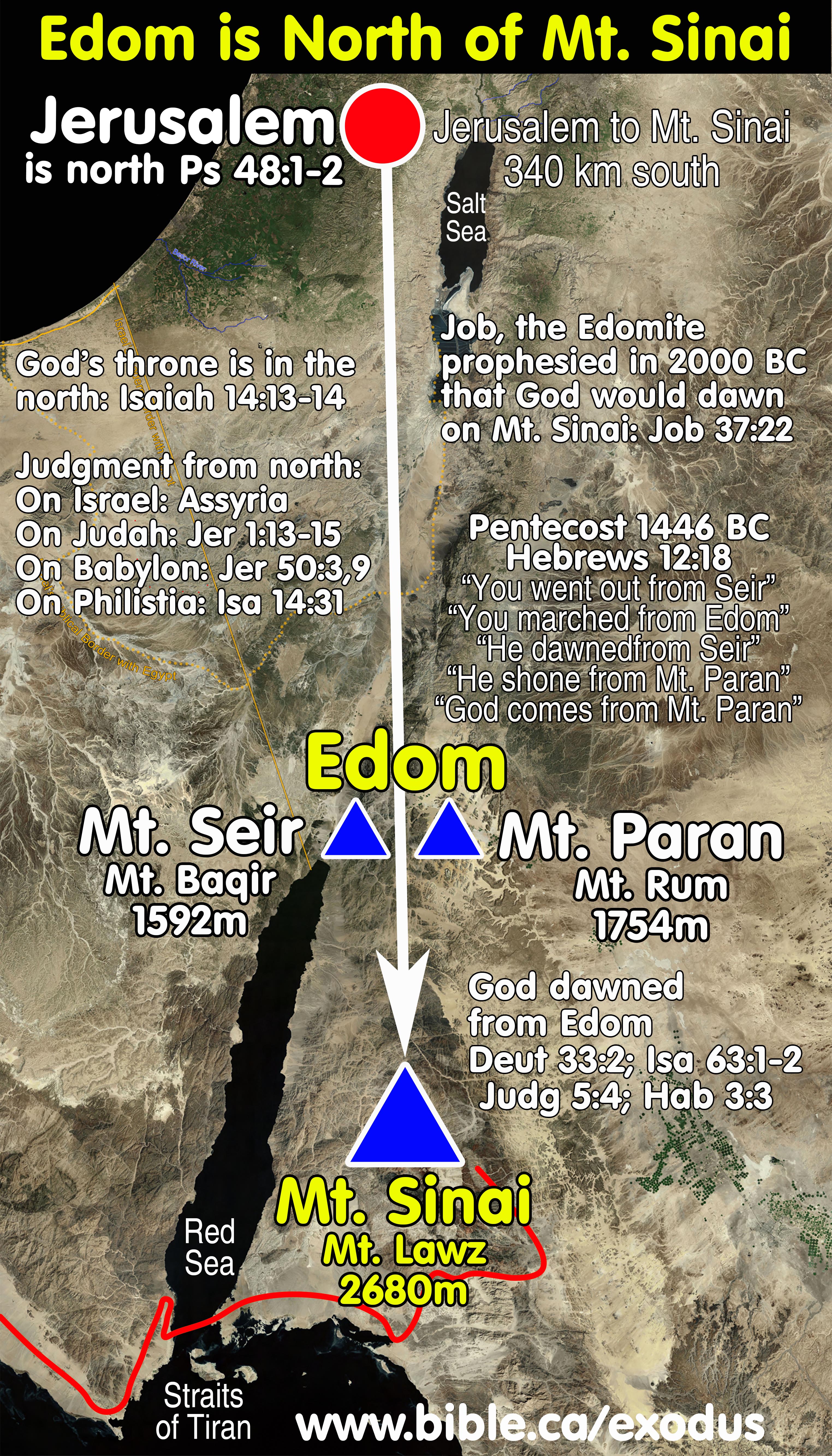 |
|
- Both scripture and Egyptian archeological sources,
confirm beyond any doubt, that the Edomites were a nation in 1800 BC.
However archeologists who reject the Bible as God's word, do not believe
the Edomites were an organization nation until about 800 BC. K. A.
Kitchen, however, has supplied clear proof that Edom was a nation in
1800 BC, just as the Bible says:
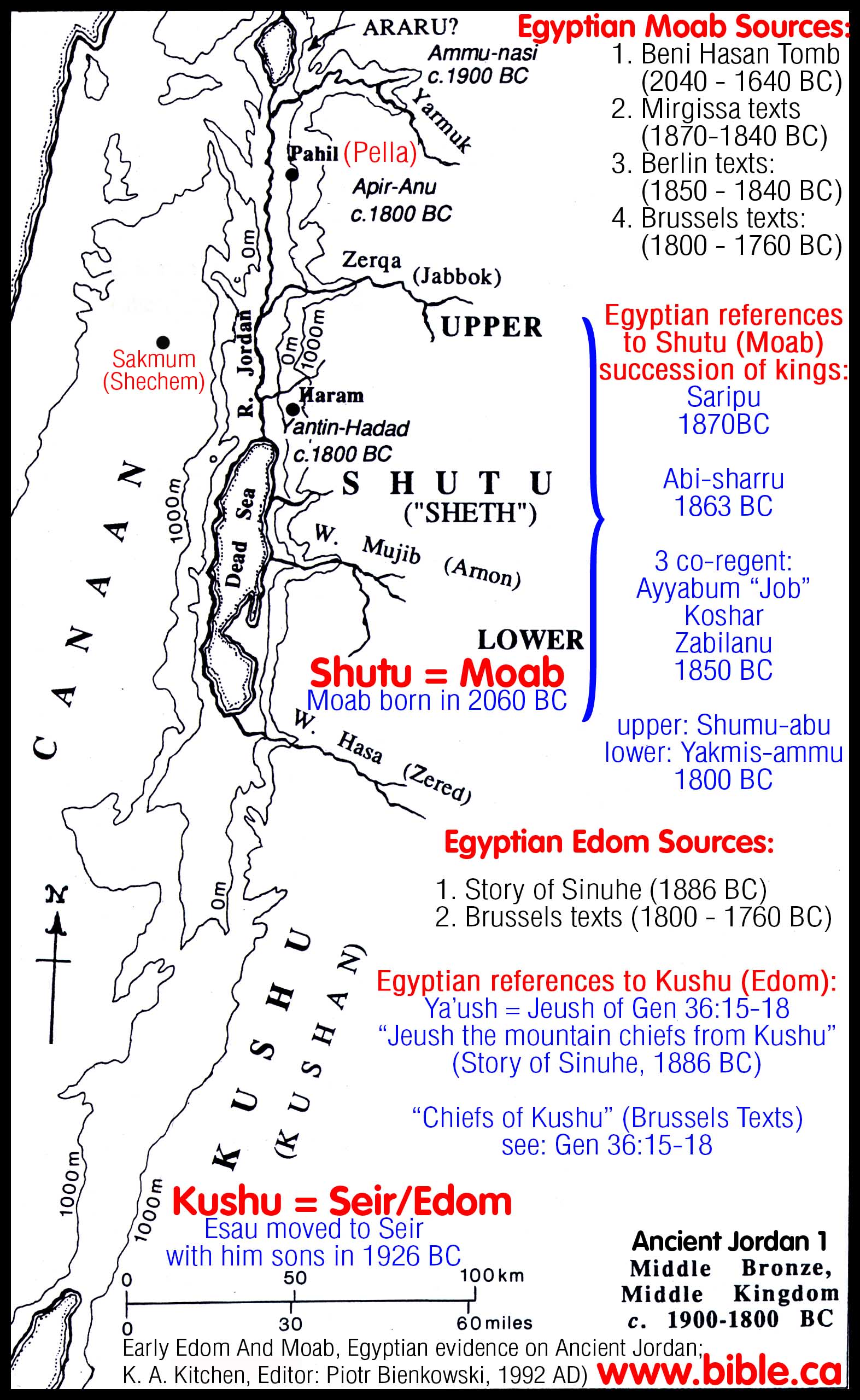
- K. A. Kitchen's map of Egyptian evidence for Edom being nation from 1900 - 1800 BC:
"There are now three series of Egyptian 'Execration Texts' that list lands and rulers on both sides of the Jordan: the Mirgissa series (Koenig 1990:111-112) of c. 1870 BC (at very latest, c. 1840 BC)1, the Berlin series (Sethe 1926) coming closely after these with identical phraseology, of c. 1850 BC (at latest, c. 1840 BC), and then the Brussels series (Posener 1940), near the end of the 12th Dynasty c. 1800 BC (at latest, c. 1760 BC). From these texts, limited but valuable facts about Jordan in Middle Bronze Age II can be gleaned.2 Locations east of the Jordan can be viewed in three groups (Figure 3.1): SHUTU is a region named in a Beni Hasan tomb, the Mirgissa texts and the Berlin texts as an area (having three rulers in the Berlin texts), later specified as Upper and Lower Shutu in the Brussels texts. The identification of this name with Sheth of 'the Sons of Sheth' as an ancient synonym for Moab(ites) in Numbers 24:16 is widely accepted and fits wel1.3 We have a virtual succession of local rulers, thus: 1. Saripu(m) (Mirgissa), c. 1870 BC (Koenig 1990:111, F.4) Abisharru visiting Egypt c. 1863 BC (Year 6 of Sesostris II; Newberry 1893:p1.28) 2. Ayyabum ('Job'; Sethe 1926:46, e-4; Albright 1928:239; 1954:225-227, 232:1), Koshar (cf. Kothar; Sethe 1926:46f., e-5; cf. Helck 1962:50), and Zabilunu ('Zebulon; Sethe 1926:47, e-6; Albright 1928:239; 1954:225-232; Helck 1962:50), being three contemporary rulers within Shutu, c. 1850 BC. 3. Shumu-abu (Posener 1940:89-90; Helck 1962:60) ruling Upper Shutu, and Yalanis-`ammu5 in Lower Shutu, c. 1800 BC. These rulers should be compared with `Ammi-inshi (or -nasi), ruler of 'Upper Retenu' in south Syria (north-west of Jordan) in the story of Sinuhe, ruling agricultural and pastoral territories within definite political boundaries with other polities.6 Some would claim (Rainey 1972:376 and n.38 [following Mazar]; Aharoni 1979:19, 143, 186, n.20) that Sinuhe's enclave within his area, 133 or 'Araru, coincides with the Araru of the later Amama Letters (EA 256), east of the Sea of Galilee and along the north side of the Yarmuk. 2. KUSHU occurs in the story of Sinuhe (c.1900 BC) and in the Brussels texts. In the former, Sinuhe summons the leader (? -hnty) Ya`ush from out of Kushu7 (Sinuhe B 220). The man's name is identical with the Ya`ush ('Jeush') of Gen. 36:5, 15 (are), 18, among the sons of Esau traditionally said to have decamped to Edom in the late patriarchal age (c. 17th century BC). In the Brussels texts (c. 1800 BC), it is of special interest that we find not 'rulers' (hew) but instead 'chiefs' (wrw) of clans (whywt) of (the territory) Kushu (Posener 1940:88-89, E 50-51)." (Early Edom And Moab, Egyptian evidence on Ancient Jordan; K. A. Kitchen, Editor: Piotr Bienkowski, 1992 AD) - "In summary, the Egyptians of the early 2nd millennium BC clearly knew of, and had contacts with, the whole line of territory east of the Jordan valley from east of Huleh south to what became Edom. Up north, Maacah is shadowy, but Araru was probably already an entity. Certainly Ashteroth, Busruna and Sur(-Bashan) were settlements on and near important routes. In later Gilead (latiore sensu), inland east of Pella, were perhaps Ramith, certainly Haram, and faraway Qarqur. Bordering south of this, Upper Shutu may have occupied the later Ammonite territory while Lower Shutu held the later Moab. South again roamed the clans of Kushu. The proper names of all the local rulers belonged to the familiar range of West Semitic ('Amorite/Canaanite') types so well-attested from the vast Mari archives and reaching back into Ur III records even before the start of the 2nd millennium BC." (Early Edom And Moab, Egyptian evidence on Ancient Jordan; K. A. Kitchen, Editor: Piotr Bienkowski, 1992 AD)
- K. A. Kitchen's map of Egyptian evidence from 1406 - 1180 BC:
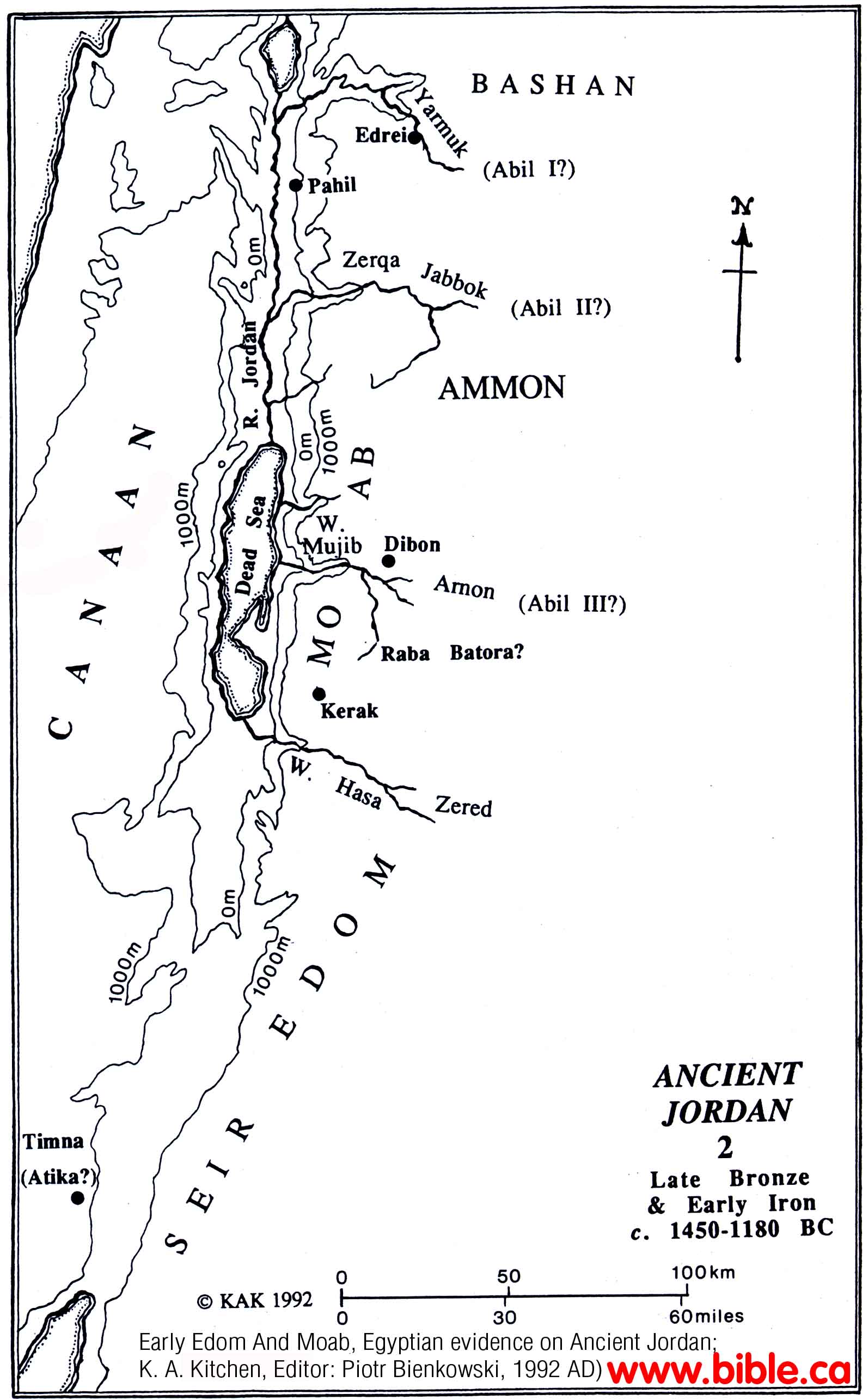
- Many archeologists suffer from a disease called, "Hittitus". The majority of archeologists are Bible trashers, namely they reject the Bible as an accurate historic and reliable record of history. These Bible trashing archeologists debate among themselves whether Edom existed as a nation either in 1000 BC or not until 700 BC. This is absurd, since the Bible says Edom descended from Jacob in 1000 BC and immediately settled in their historic lands east of the Arabah valley between Petra and the Red Sea: "Now these are the records of the generations of Esau (that is, Edom)." Genesis 36:1; "So Esau lived in the hill country of Seir; Esau is Edom." Genesis 36:8
- The Bible clearly identifies a succession of Kings of Edom starting with Esau: "Now these are the names of the chiefs descended from Esau, according to their families and their localities, by their names: chief Timna, chief Alvah, chief Jetheth, chief Oholibamah, chief Elah, chief Pinon, chief Kenaz, chief Teman, chief Mibzar, chief Magdiel, chief Iram. These are the chiefs of Edom (that is, Esau, the father of the Edomites), according to their habitations in the land of their possession." Genesis 36:40-43
- In spite of this clear, inspired by God information, that Esau lived in Mt. Seir from about 1920 BC, faithless archeologists have determined that the nation of Edom got its identity from a land area merely named Edom. They teach that first there was the transjordan land area named Edom, but there were no Edomites. The land was just called Edom. Then, over time, nomads moved into this area and became known as the Edomites. The truth is, that Esau moved into a previously uninhabited area that was named Edom because of the people living there. For archeologists, the land came first, then the people were named after the land. For the Bible believer, Esau moved into this land, which was then named after him.
- At the birth of Esau, he was stated to be a nation: "The Lord said to her, "Two nations are in your womb; And two peoples will be separated from your body; And one people shall be stronger than the other; And the older shall serve the younger."" Genesis 25:23
|
The Bible
|
Bible trashing archeologists
Disease: Hittitus |
| At the very beginning of civilization, Cain was a framer of grain and Able was a herder of sheep. Esau and Jacob were herders and breeders of domesticated animals in 1920 BC. | Man had not evolved enough from the "blob in the sea", to understand about herding animals until about 1000 BC. Even in 1000 BC they were only hunters of wild animals and picked wild fruits and nut for food. |
| The Edomites got their name from Esau after he moved there and occupied the land. The land "Edom" was named after the descendants of Esau moved there. | The land was first called Edom, then a group uncivilized "hunter/gatherers" started roaming the land and they took the name "Edomites" from the land. |
| Edom was an organized nation headed by a king at the time of the exodus in 1446 BC. | Edom did not exist as a nation until about 700 BC. |
- Those who reject that Edom was an organized nation before 700 BC, make a big point about finding no major cities. They insist that Edom was nomadic and living in tents, herding their flocks and use this as their proof. However is has escaped their notice that Edom was living in tents and had few sedentary living areas. This does not diminish the reality that if you set foot on their turf, that they would be a real force to be feared.
- Kitchen has discussed this in relation with other ancient cultures like the Edomites. He describes them as "kings who lived in tents". He concludes that the lack of finding cities and other "material evidence" is "unreliable as negative evidence" to prove Edom did not exist at the same time. In other words, We know from "archeological lists" that both Mesopotamia and Edom were governed by kings. Yet apart from this we find no further evidence. Kitchen says it is invalid to reject Edom's nationhood on the basis of finding little archeological evidence during the period of 1900-1500 BC. The proof Kitchen uses that Edom was a kingdom is the list in the Bible. Kitchen points out that it is unfair for archeologists to reject Edom as a kingdom, since they accept the kingdoms of Mesopotamia with similar kinds of lists.
- "In western Palestine, the Execration Texts also have not only urban centres but also tribal groups linked with them. This finds a direct counterpart in contemporary Old Babylonian Mesopotamia, where it seems clear that we now have lines of kings over tribal groups (or confederations) reigning in given areas contemporaneously with rulers of urban states there. Such also would have been the Assyrian King List's early 'kings who lived in tents', and not merely fictions (Yuhong and Dailey Early Edom and Moab: The Beginning of the Iron Age in Southern Jordan 1990). Clearly, if it were not for the attestations of such tribal kings in cuneiform documents with their urban counterparts, we would (archaeologically) know nothing of them. Thus, the relatively poor, even fugitive attestation of material evidence for the Middle and Late Bronze Ages in (later) Edom and Moab is equally unreliable as negative evidence, if (as is most probable) the rulers of Shutu and clan- chiefs of Kushu were agro-pastoralists and largely nomadic pastoralists respectively. ... The side-by-side existence of settled rulers and more tribal chiefs finds a societal echo in contemporary Old Babylonian Mesopotamia, where Amorite tribal 'kings' ruled in the same general areas also subject to the dynasts reigning in specific cities; documents bear oaths sworn in the joint names of such 'complementary' rulers, for example (Yuhong and Dalley 1990)." (Early Edom And Moab, Egyptian evidence on Ancient Jordan; K. A. Kitchen, Editor: Piotr Bienkowski, 1992 AD)
- "This is entirely consistent with the pastoralists of Merenptah's time, and the raid on Seir by Ramesses III (an action repeating the claim of Ramesses II) may have been linked with Egyptian mining interests in Timna in both reigns, and the security of those interests. Clearly, Seir/Edom was not just a deserted wilderness in the Late Bronze/Iron Age transitional period — there were enough people there to concern Egyptian official interests, and the lifestyle was (at least in part) pastoral and (with tents) at least semi- nomadic. The consequent scarcity of tangible physical remains in the archaeological record is, therefore, not surprising; cf. above on the tented tribal kings of the Old Babylonian period. Moab, and especially Edom, should be considered mainly as 'tented kingdoms', likewise, in at any rate the 13th to perhaps the 9th centuries BC, as a result." (Early Edom And Moab, Egyptian evidence on Ancient Jordan; K. A. Kitchen, Editor: Piotr Bienkowski, 1992 AD)
- In the Story of Sinuhe, we have a reference to one of the "Jeush, one of the Chiefs of Edom" mentioned in Gen 36:15-18.
- The Story of Sinuhe says: "May then your Majesty command to have brought to you the prince of Meki from Qedem, Jeush the mountain chiefs from Kushu." [Khentiaush from Khentkesh = Jeush the mountain chiefs from Kushu]
- The Egyptians referred to the land of Edom as the Kushu. In the story of Sinuhe, dated 1900 BC, there is a reference to one of the "chiefs of the Kushu" whose name is Jeush.
- Jeush is listed as one of the chiefs of Edom in Gen 36:15-18. Amazingly, the Jeush of Gen 36 lived at the same time as the story of Sinuhe was written. It is our conclusion that the story of Sinuhe is a literal reference to the actual Jeush of Gen 36!
- This shows that Edom was an organized and recognized nation in 1900 BC.
- "Late 2nd millennium BC: 19th-20th Dynasties, c. 1300-1170 BC: In terms of Egypt east of the Jordan, Sethos I [Seti 1] (c. 1294/90-1279 BC) follows on from the evidence of the Amarna letters. They showed Egyptian overlordship in Geshur and Bashan, north of the Yarmuk — and at Tell esh-Shihab was found a stela of Sethos I (PM VII:383; text in KRI 1:17). Regrettably, only the top half has survived, showing the king before the deities Amun and Mut of Thebes — any historical details have been lost with the now missing lower half that would have contained the main text of the monument. Tell esh-Shihab itself may have been the Kheni (`Ain?)-anab of EA 256, and the Qiryath-`Anab of Papyrus Anastasi I under Ramesses 11.20 In the topographical lists of Sethos I, the sole Transjordanian location known to be named is Pahil (Pella), and this repeatedly.21 The people of Pahil were reported as siding with the rebel chief of nearby Hammath in seizing the Egyptian centre at Beth-Shan.22 A list of toponyms on a granite sphinx now at the Palace of Diocletian at Split may date to this reign or — probably — earlier; at No. 28, it mentions Ashteroth (of Bashan) (KRI 1:36:13, No.8)." (Early Edom And Moab, Egyptian evidence on Ancient Jordan; K. A. Kitchen, Editor: Piotr Bienkowski, 1992 AD)
- Although the Bible says that the exodus took place at 1446 BC, most Christians blindly follow the lead of Bible trashing archeologists who teach the exodus took place in 1250 BC, where Ramesses II was the pharaoh. In fact Tuthmoses III was the pharaoh of the exodus.
- There is some rather stunning archeological evidence at the time of Ramesses II, that Edom was an organized nation. This should not surprise us, since the Bible says that Moses asked permission of both Edom and Moab to cross their land in 1406 BC. Ramesses II was 250 years later!
- Ramesses II boasts of defeating "the mountain of Seir" and "plunders the mountain ridges of the Shasu". He also makes direct reference to Dibon, in the land of Moab.
- "Under Ramesses II (c. 1279-1213 BC), our information shows a definite increase. In his topographical lists at Karnak, Pahil recurs. ... More important are the explicit references to Moab and Seir/Edom from Ramesses II through to Ramesses III and later. First, we may deal with Seir/Edom. The sometimes disputed mention of Seir in the Amara West list, under Shasu-lands, would simply have been copied from that of Amenophis III at Soleb, in a part not now extant. In texts of his own time, Ramesses II twice describes himself as one 'who plunders the mountain of Seir with his valiant arm; in context, Shasu is used in parallel phrases.24 On another stela from Tell er-Retabeh (east Delta), he 'plunders their [=the Shasu's] (mountain) ridges, slaying their people and building with towns (dmi) bearing his name'.25 The location of this Shasu (not paralleled by Seir) remains uncertain. But the mountain of Seir is already a fixed expression, reminiscent of the Hebrew phrase Mount Seir.26 What we learn from this is limited but of some value, namely that Seir was hilly (as in Hebrew sources), and that in the 13th century BC it was worth Ramesses II either raiding it or claiming it as subdued." (Early Edom And Moab, Egyptian evidence on Ancient Jordan; K. A. Kitchen, Editor: Piotr Bienkowski, 1992 AD)
- "Now we return north, to Moab, and back in time to Ramesses II. For over 80 years, the occurrence of Moab as an undoubted place-name in a topographical list of Ramesses II has been universally recognized.31 Therefore it is hardly surprising that further records of Moab in this reign should have come to light. A few decades ago, clearances by the exterior east wall of the forecourt of Ramesses II at the temple of Luxor laid bare two whole registers of war-scenes of Ramesses II (Kitchen 1964; texts, recollated, KRI II:179-183). The names of forts in the upper register indicated a Syrian locale for the events there depicted: an Apheq and Krmyn, known from other Syrian war-scenes of this reign. In the lower register, the place-names are mostly palimpsest. The names of places captured were plastered-over, and the new surface recut with names that relate to the Syrian locale of the upper register: Shabduna, the Shabtuna of Qadesh fame, and Da[l]at=Silul, 'Door of the Locusts', only otherwise known from a Ramesses II topographical list at Luxor itself. But our interest is in the original names of the lower register. In the first (north) scene, captives are led away from below a conventionally-drawn fort, whose original label reads very clearly: "Town (dmi) that Pharaoh's arm captured in the land of Moab: Btrt (Butartu)." Despite being inscribed in palimpsest with the plaster gone, almost every significant sign of both versions can be read with complete assurance. So, the scenario of this activity is in Moab beyond any possible dispute.35 The case for identifying Btrt as Raba Batora was made long ago, and is not easily bettered, locating this place at some 14 miles/23 km. south of the Arnon, or about 57 miles/92 km. south of Amman. The second scene has two places. The first has resisted any convincing identification: Yn( ?)d... or Y(..)d... in the mountain of Mrrn. The second is labelled, again, with no possible doubt as to the reading: "Town (dmi) that Pharaoh's arm [captur]ed: Tibunu." In this strictly Moabite context, this name is, and can only be, Dibon. In the third scene, no further names are readably preserved. There is, therefore, no factual doubt whatsoever about the readings of the names Moab, Butartu, Tibunu, and no convincing alternative to interpreting these three names as standing for Moab, (Raba) Batora and Dibon. That is — or should have been — the end of the matter, if normal scholarly standards were to prevail. Unfortunately, in biblical studies, they do not; and a veritable 'ignoramus choir' has done its best to evade the clear impact of this evidence." (Early Edom And Moab, Egyptian evidence on Ancient Jordan; K. A. Kitchen, Editor: Piotr Bienkowski, 1992 AD)
- Pharaoh Merenptah is the first one in history to use the term Edom, as opposed to Shatu, for the Edomites. This does not mean that the term Edom was not used earlier than 1206 BC, it just represents the first solid proof from archeology of the term "Edom."
- "Some 60 or more years later, in the eighth year of Merenptah, c. 1206 BC, the term Edom appears for the first time. Papyrus Anastasi VI contains the following well-known report (lines 51-61): "We have finished with allowing the Shasu clansfolk of Edom to pass the fort of Merenptah that is in Succoth ['Tjeku'], to the pools (brkt) of Pi-Atum of Merenptah that (is/are) in Succoth, to keep them alive and to keep alive their livestock, by the will of Pharaoh, LPH, the good Sun of Egypt, along with the names from the other days on which the fort of Merenptah that is in Succoth was passed [by such people...] (text, Gardiner 1937:76-77; translations, e.g. ANET:259; with notes, Caminos 1954:293)." (Early Edom And Moab, Egyptian evidence on Ancient Jordan; K. A. Kitchen, Editor: Piotr Bienkowski, 1992 AD)
- Ramesses III makes direct claims to having destroyed Edom. He uses Seirites interchangeably with Shasu.
- It also shows that they had tents and where shepherds. Being tent dwelling shepherds does not diminish the fact they were an organized kingdom.
- "The picture is one of pastoralists with their livestock, which agrees well with the next item in the dossier. That in turn comes from the reign of Ramesses III (c. 1184-1153 BC). Between accounts of his conflicts with the Sea Peoples and with the Libyans (also attested on the walls of his temple at Medinet Habu), there appears the following passage (Papyrus Harris I, 76:9-11): "I destroyed the Seirites, the clans of the Shasu, I pillaged their tents [using the West Semitic term 'ohel, with their people, their property, and their livestock likewise, without limit..." (text, Erichsen 1933:93; translation, e.g. ANET:262:I; cf. Grdseloff 1947:87-88)." (Early Edom And Moab, Egyptian evidence on Ancient Jordan; K. A. Kitchen, Editor: Piotr Bienkowski, 1992 AD)
- "Papyrus Moscow 127" is dated to at or before 1000 BC.
- This is the same time that the king of Edom named Hadad, fled to Egypt as a boy when David Attacked Edom. After David died, Hadad returned to Edom.
- "A century or more later brings us to a peculiar, perhaps literary letter of c. 1000 BC (at least in our extant MS — composition may have been earlier). Here, one dispossessed Egyptian official begs of another that his dire plight might be relieved (Papyrus Moscow 127; Caminos 1977:66-69, 72, pls.11/12, Co1.5:4-5). Right at the end, the man utters in rhetorical vein: 'Oh that I could send him [his local oppressor] off to Nahar(in),27 to fetch the hidden tmrgn,28 with whom he had (previously) gone to those of Seir!'29 This comes close in date to the reported flight of the baby prince of Edom into 21st- Dynasty Egypt (1 Kings 11:14-22).30 Thus, we have at least some evidence for an inhabited Edom/Seir — and having intermittent relations with Egypt — from the 13th into the 10th centuries BC." (Early Edom And Moab, Egyptian evidence on Ancient Jordan; K. A. Kitchen, Editor: Piotr Bienkowski, 1992 AD)
- Many people do not realize that just as there are dishonest evolutionists who deliberately teach debunked "science" to prove man came from an ape, so too in archeology. Most Christians do not realize that most Biblical archeologists are Bible trashers: They do not believe the Bible is God's inspired word. They reject the flood story, believe that the exodus is a myth, David and Solomon were never kings as described in the Bible, that the book of Deuteronomy was written in 600 BC rather than 1446 BC.
- K. A. Kitchen is a an archeologist who is a defender of scripture. Below we have given you his refutation of Bible trashers who do not believe Edom or Moab were nations earlier than about 800 BC.
- Specifically the discussion is about an inscription from the time of Ramesses II that says: "Town (dmi) that Pharaoh's arm [captur]ed: Tibunu." Kitchen, being a world authority on Egyptian history, shows that Tibunu is the town of Dibon, in Moabite territory. This is a huge problem for Bible trashers because if Tibunu is the town of Dibon, then it proves Moab was an organized kingdom at about 1250 BC (the time of Ramesses II). Kitchen exposes their deceptive and unscholarly attempt to mislead the world (an unsuspecting Christians) into believing that this evidence is invalid.
- "Town (dmi) that Pharaoh's arm [captur]ed: Tibunu. In this strictly Moabite context, this name is, and can only be, Dibon. In the third scene, no further names are readably preserved. There is, therefore, no factual doubt whatsoever about the readings of the names Moab, Butartu, Tibunu, and no convincing alternative to interpreting these three names as standing for Moab, (Raba) Batora and Dibon. That is — or should have been — the end of the matter, if normal scholarly standards were to prevail. Unfortunately, in biblical studies, they do not; and a veritable 'ignoramus choir' has done its best to evade the clear impact of this evidence. First came Ahituv (1972) in a paper swarming with careless inaccuracies,37 wrongly locating Tibunu in Galilee, in the wake of Aharoni's placement of Tuthmoside Tpn, itself now ruled out by Redford's study (Redford 1982a, 1982b:118-119). Ahituv's blunders were completely refuted soon afterwards by this writer (Kitchen 1976), a fact conveniently ignored by some commentators.38 Totally misleading were the remarks by Miller (1977:250-251), entirely wrongly claiming that this writer's readings were 'open to question' and that 'the names "Moab" and "Dibon" could be read only after prolonged study which involved some reconstruction of the text'. As has been made clear already above, exactly the opposite is true. There is no doubt about the physical readings of Moab, Dibon or Butartu; prolonged study and recollations were devoted to the wall specifically to ensure that no fundamental error could creep into its decipherment; and there was no 'reconstruction' of the text other than in minor details. In any future edition of that work, Miller's remarks require to be publicly retracted. In turn in 1979, Weippert indulged in equally misleading speculations (1979:27 and n.44). First, the type of fort shown (be it 2b or whatever) is irrelevant; whenever the places named on such forts can be identified, they were proper settlements — and the term dmi, 'town', means a proper settlement (even if small), not merely a few tents of moving nomads. Therefore, we do know that Ramesses II did capture either a fort or a settlement, if of unknown size, contrary to Weippert's misleading remarks. Second, Weippert blindly follows Ahituv over Tibunu, in total disregard of the relevant facts about context, spelling, etc., set out by the writer in 1976. Third, Weippert's ideas about *Yud-hamelek for Yni?]d[...] are worthless; the probable n would preclude his idea completely, and the alternative w, likewise. Thus, his denials of a Moabite locale are totally without factual foundation and must be dismissed. Then in 1981, Weinstein blindly and wholly uncritically followed the errors of Ahituv, in total ignorance of the refutation of those errors (1981:21). Aliituv in 1984 merely repeated his mistakes of over a decade before, without the slightest attempt to discuss any other views or contrary facts, in a work damned by others for its incompetence.39 His excuse (shared by others) that no Late Bronze remains are attested at Dibon is facile (cf. below), and — curiously — is an excuse that rarely prevents him from accepting other identifications that suit him; cf. his pp.103 (Gibeon), 115/6 (Hashabu), 116 (Hasi), 131 and n.33 (Labwe), and 147 (Na'aman). Clearly, double standards rule here. Finally, we have F.M. Cross who, in a hasty and ill-conceived addendum to a footnote, peremptorily rejected the clear equation of Tibunu — Dibon on the say-so of Ahituv, Weippert and Weinstein, without the slightest attempt to verify the facts (Cross 1988:58f., n.41, second part). 'I've got my pet theory, don't confuse me with contrary facts' represents his approach and the absolute nadir of scholarship. The whole tissue of nonsense, therefore, may be set aside in favour of the facts. Moab was a real entity in the 13th century BC, sufficiently to engage the attentions of Ramesses II. While it (like Edom) may have had a considerable pastoral/semi-nomadic element, it also had a certain number of settlements, and some — including Dibon and (Raba) Batora — are named by Ramesses. The 'Mount Mrrn' is some strategic spur whose name has simply not come down to us in any continuous tradition.40 The date of Ramesses II's campaign into Moab is unknown; it is probably best dated after Year 9, as recently suggested." (Early Edom And Moab, Egyptian evidence on Ancient Jordan; K. A. Kitchen, Editor: Piotr Bienkowski, 1992 AD)
- Edom was an organized and recognized nation in 1900 BC. The Bible clearly states this. There is a vast amount of irrefutable evidence to prove this from Egyptian sources. Those "Bible trashing" archeologists who teach Edom was not a nation until about 700 BC stand in direct contradiction to not only the Bible, but actual archeological evidence.
- From the earliest time, Edom's geographic domain was transjordan. The Edomites never lived in the Negev or the "land of Judah" until the Babylonian captivity in about 587 BC.
- At the time of the exodus, Edom's border was the eastern mountain range of the Arabah valley. Their kingdom was in modern Jordan.
- This is a clear and powerful proof that Kadesh Barnea cannot be located at Qudeirat, since the border of Edom was next to Kadesh Barnea.
- Modern maps since 1916 AD have wrongly placed Kadesh at Qudeirat and therefore also placed Edom's border inside Judah beside Qudeirat. This is a gross and misleading error that is refuted by the Bible itself, but the testimony of Egyptian archeology and what we know from archeology in the transjordan area.
By Steve Rudd: Contact the author for comments, input or corrections.

No comments:
Post a Comment